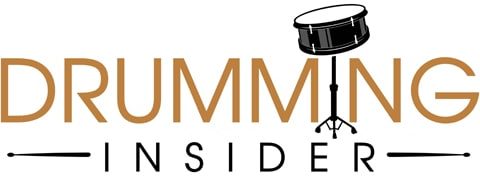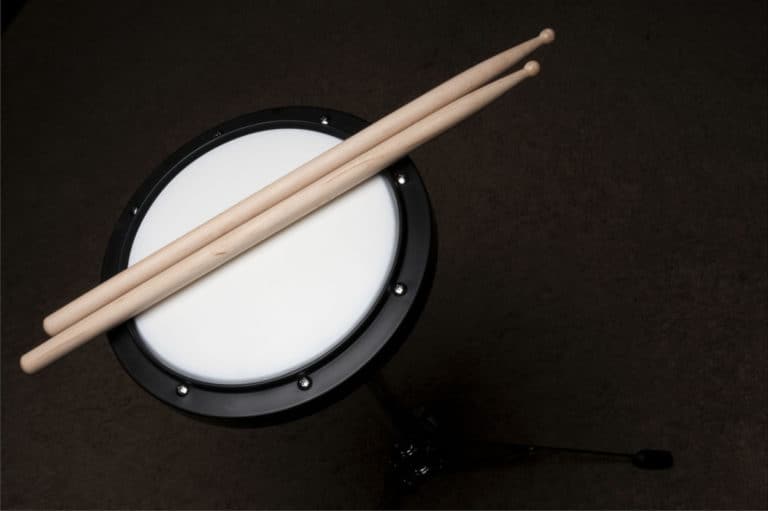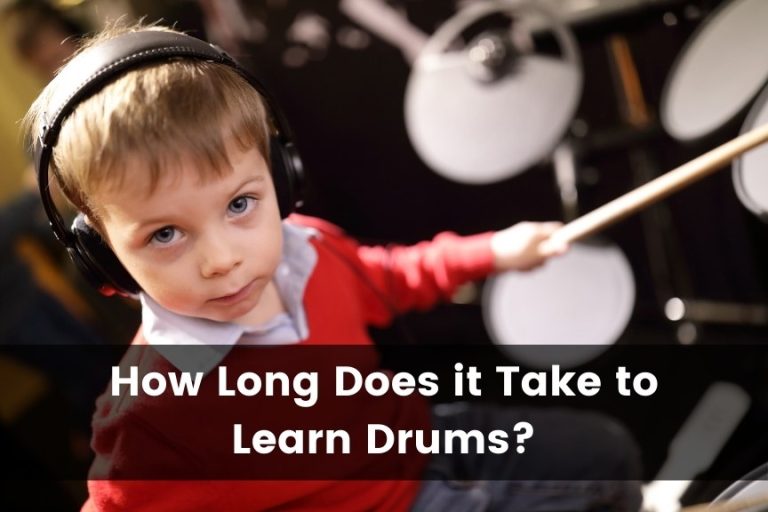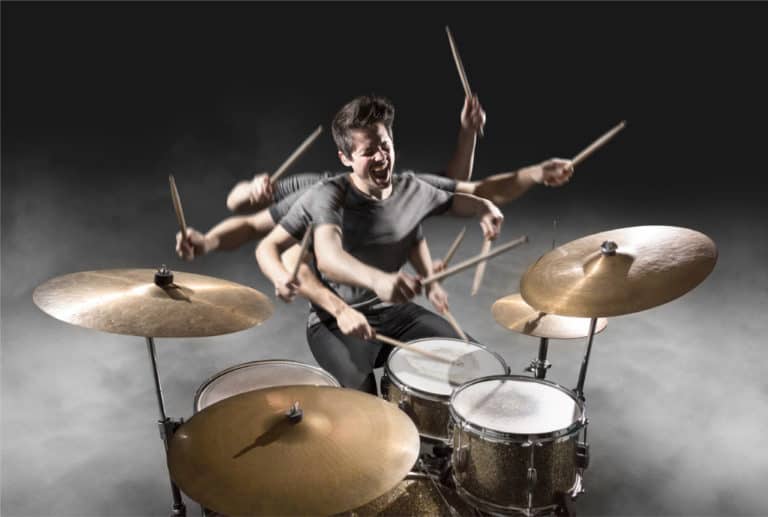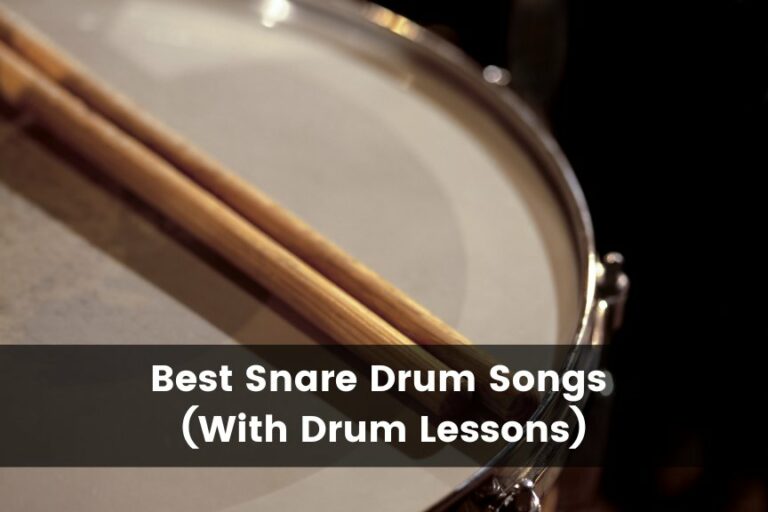25 Best Jazz Drum Songs (With Tabs + Videos)
Jazz music stirs the soul, invoking in us strong emotions and deep memories. Although jazz isn’t a genre that celebrates the drums too often, today, we want to change that. We’ve put together this comprehensive list of the 25 best jazz songs with drums.
Whether you prefer the smooth stylings of Duke Ellington or the classic jazz of John Coltrane, there’s something from all the biggest names in jazz on this list. Check it out!
1. “Take Five” by the Dave Brubeck Quartet
| Release Date | 1959 |
| Genre/Style | Jazz |
| Tempo (BPM) | 174 |
When Dave Brubeck of the eponymous Dave Brubeck Quartet came up with the inspiration for “Take Five,” he did so because he thought jazz at the time wasn’t as adventurous or rhythmically challenging anymore.
Well, he sure solved that problem with the creation of this song! This track on the 1959 album Time Out really showcases musical excellence. The drum fills here don’t follow the main rhythm of the song, venturing off on their own to lend the tune a distinct sound that surely matched Brubeck’s vision.
2. “Sing, Sing, Sing” by Benny Goodman
| Release Date | 1937 |
| Genre/Style | Jazz, swing |
| Tempo (BPM) | 112 |
“Sing, Sing, Sing” is one of the best-known jazz songs, as it’s appeared in films such as 1936’s After the Thin Man, 1995’s Casino, 2003’s Bright Young Things, 2015’s The Wedding Ringer, and 2022’s Don’t Worry Darling. Combining elements of swing and jazz, it’s one of the most iconic songs ever recorded.
It also has some pervasive, pounding drums that lend the song its entire electric atmosphere. The 112-beat-per-minute pace of the tune sounds slower than what your ears hear but keeps the track just danceable enough.
3. “Caravan” by Duke Ellington
| Release Date | 1936 |
| Genre/Style | Jazz |
| Tempo (BPM) | 107 |
The beloved jazz classic hit “Caravan” by Duke Ellington and Juan Tizol has a variety of styles intermingling into one supersonic adventure. The drums, originally played by Sonny Greer, have a pulsating feel that punctuates the slick brass section.
The song switches between smooth jazz and elements of swing, vacillating between the two with such ease that it only seems right that this is an Ellington song, as he’s a jazz master. It’s an adventure to listen to on the drums and just as fun to play.
4. “A Love Supreme” by John Coltrane
| Release Date | 1965 |
| Genre/Style | Jazz |
| Tempo (BPM) | 180 |
A Love Supreme is a John Coltrane record with a song of the same name. It’s a unique one because it’s split into four parts. Part 1, “Acknowledgement,” is nearly eight minutes long, while Part 2, “Resolution,” is seven and a half minutes long.
The third part, “Pursuance,” is combined with Part 4, “Psalm,” and is altogether nearly 18 minutes. As you get lost in the immersive, lengthy listening experience, one can’t neglect praising the incredible drum work of Elvin Jones, who also handled timpani and gong duties on the track.
The sheer stamina of Jones to play for 30 minutes across four distinct tracks is amazing!
5. “Moanin’” by Art Blakely and the Jazz Messengers
| Release Date | 1959 |
| Genre/Style | Jazz, hard bop |
| Tempo (BPM) | 130 |
Art Blakely and the Jazz Messengers deserve a spot on this list for the soulful, jazzy tune “Moanin,’” released in 1959 off the eponymous album. The nearly 10-minute song follows a call-and-response format while the drums hold steady so the brass instruments can shine.
The attractive drum rhythm, although it’s mostly simple, holds this song together and allows each instrument to venture out and respond to one another so you can enjoy the sonic symphony inspired by Charles Mingus and Horace Silver.
6. “Spain” by Chick Corea
| Release Date | 1973 |
| Genre/Style | Jazz, new age |
| Tempo (BPM) | 136 |
The track “Spain” is off Chick Corea’s award-winning album Light as a Feather, which received two Grammy noms (for Best Instrument Performance by a Group and Best Instrumental Arrangement) and one Grammy win for Best Instrumental Arrangement.
The almost 10-minute track starts off slow and picks up. It’s around the three-minute mark where the drums kick in, invoking more drama and pacing to the tune and grounding it. It’s easy to lose yourself in the entire rhythm of the song, which is smoothly augmented by the drums but never dominated by them.
Even when the song has more hi-hats than gentle drum pattering, the drums blend in smoothly and keep the track chugging along.
7. “Straight, No Chaser” by Thelonious Monk
| Release Date | 1967 |
| Genre/Style | Jazz, blues |
| Tempo (BPM) | 93 |
Next, we have “Straight, No Chaser,” the first of several Thelonious Monk songs that will appear on this list of the best jazz drum songs. Released off the album of the same name, “Straight, No Chaser” is a 10-minute, twelve-bar song with jazz and blues stylings in a beautiful marriage.
The chromatic melody is a Monk staple. Although it’s a shorter song, clocking in at under three minutes, it’s got jaunty drums in a light tip-tap ambiance that entreats the true spirit of jazz. It’s not a challenging song to sit behind the kit and play if you’re interested in learning!
8. “Giant Steps” by John Coltrane
| Release Date | 1960 |
| Genre/Style | Jazz |
| Tempo (BPM) | 300 |
“Giant Steps” by John Coltrane, released on the 1960 album of the same name, is a near-five-minute track that follows a cyclic chord pattern that later became characterized as one of several Coltrane changes, which are shifts in harmonic progression.
The song is a speedy one, achieving 300 BPM, and switches keys three times, going from B major to G major and later, E♭ major. It was once called “the most feared song in jazz” because it’s so technically challenging even though it’s so nice to listen to.
9. “In a Silent Way” by Miles Davis
| Release Date | 1969 |
| Genre/Style | Avant-garde jazz, jazz fusion |
| Tempo (BPM) | 132 |
The Miles Davis hit, “In a Silent Way,” undoubtedly must be on this list. The 20-minute avant-garde jazz number, released on an album of the same name, was part of Davis’s electric phase. The song begins with ambient guitar and really wakes up around the four-minute mark.
It’s then that the jazz flavor shines deliciously. The song slows down, picks up again, and slows down some more. Every instrumentalist on the track deserves acclaim for playing expertly across 20 minutes, but we quite admire the drums, which have a beautiful rhythm that acts as this song’s glue.
10. “Blue Train” by John Coltrane
| Release Date | 1958 |
| Genre/Style | Jazz, hard bop |
| Tempo (BPM) | 123 |
Another jazz drum classic from Coltrane comes courtesy of the 1958 album Blue Train and the eponymous song. This jazz standard combines both minor and major qualities by using the minor and major third simultaneously. It’s another wise musical move by a man that made many of them.
Besides the unique qualities of the song, there’s also the length, which is nearly 11 minutes. It’s for both those reasons that we declare this one of the best jazz drum songs in existence. Turn it on and let yourself drift away to a simpler time through this everlasting hit.
11. “All Blues” by Miles Davis
| Release Date | 1959 |
| Genre/Style | Modal jazz |
| Tempo (BPM) | 138 |
We must give another nod to the all-time blues great Miles Davis with the inclusion of the song “All Blues.” This track from Kind of Blue features twelve-bar blues in 6/8. This track is also a mixolydian.
Jimmy Cobb played the drums on this track, a member of the First Great Sextet with Davis. This 11-minute track shows off his instrumental mastery and command over the sticks. The drums are as smooth as butter, a soft, inclusive sound across the duration of the song and part of what makes “All Blues” so enduringly great.
12. “Afro Blue” by John Coltrane
| Release Date | 1963 |
| Genre/Style | Jazz |
| Tempo (BPM) | 100 |
“Afro Blue” is a song originally recorded by Mongo Santamaria in 1959 as part of the Cal Tjader Sextet. There was another version that same year with vocals written by Oscar Brown and recorded by Abbey Lincoln. Then there’s the Coltrane version in 1963, which features his trusty drummer Elvin Jones.
Jones decided to try the song on drums differently from how Santamaria had done it. He superimposed dual cross-beats over the ¾ waltz measures. In other words, Jones and Coltrane took the metric hierarchy of the original version and reversed it. Pretty smart stuff!
13. “Bemsha Swing” by Thelonious Monk
| Release Date | 1952 |
| Genre/Style | Jazz |
| Tempo (BPM) | 91 |
Thelonious Monk’s collaboration with Denzil Best, a jazz composer and percussionist, resulted in “Bemsha Swing,” sometimes spelled “Bimsha Swing.” The alternate name refers to Bimshire or Barbados, where Best’s family hails from.
The sixteen-bar track follows AABA form. One section, the A-section, uses four bars and adds tones used in parallel minor C scales but transposed to add a B section. The swinging, jazzy song is a true masterpiece of the genre, with a catchy rhythm and plenty of hi-hats that sound great.
14. “Naima” by John Coltrane
| Release Date | 1959 |
| Genre/Style | Jazz |
| Tempo (BPM) | 171 |
Another track from John Coltrane’s Giant Steps album that deserves a spot as one of the best jazz drum songs of all time is “Naima.” The track is named after Juanita Naima Grubbs, Coltrane’s wife at the time. It’s one of the best-known songs in his vast catalog.
The original track expands over four-and-a-half minutes, a smooth, melodic ride with drums keeping pace at 171 BPM. Coltrane has recorded “Naima” many a time, again in 1961, 1966, 1977, 1997, and as recently as 2019. The song gets better every time!
15. “My Favorite Things” by John Coltrane
| Release Date | 1961 |
| Genre/Style | Jazz, modal jazz, free jazz |
| Tempo (BPM) | 179 |
Arguably one of the most enduring jazz songs–actually, one of the most enduring songs, period–is “My Favorite Things.” The Coltrane version doesn’t talk about whiskers on kittens or cream-colored ponies, but expands upon the original, as this track is 14 minutes.
Coltrane plays in an E minor. The drums back up this song and help it achieve jazz supremacy, so of course we had to spotlight it here. By the way, if you’re wondering when the song became a Christmas tune, that appears to have happened in the 1960s.
16. “So What” by Miles Davis
| Release Date | 1959 |
| Genre/Style | Modal jazz, jazz |
| Tempo (BPM) | 134 |
Another Jimmy Cobb and Miles Davis masterpiece is “So What” from the critically acclaimed 1959 record Kind of Blue. The first track on the album, this nine-minute tune sets the mood for what’s to come. Following the Dorian mode of modal jazz, the song uses sixteen bars first of D Dorian, then eight bars of E♭ Dorian, then another eight of the original D Dorian.
The intro starts heavily with bass and piano before transitioning into the other instruments, including that sweet drumming by Cobb. The original recording has a mild 134 BPM tempo, but if you ever listen to this track live, you’ll notice that Davis and his backing band sped up the tempo considerably.
17. “The Sidewinder” by Lee Morgan
| Release Date | 1964 |
| Genre/Style | Jazz, hard bop |
| Tempo (BPM) | 151 |
The jazz standard “The Sidewinder” by Lee Morgan comes from one of the biggest names in hard bop from the 1960s. The album of the same year from 1963 starts with this 10-minute track, which Morgan named after television villains more than he did the snake.
The jazz tune with its bouncy drums switches to a minor chord between bars 17 and 18. Billy Higgins plays drums on the commercially viable tune. He’s worked with many jazz greats, from Gene Ammons to Gary Bartz, Donald Byrd, and Don Cherry.
18. “West Coast Blues” by Wes Montgomery
| Release Date | 1960 |
| Genre/Style | Jazz |
| Tempo (BPM) | 153 |
Wes Montgomery was godlike on jazz guitar, which explains why he named the album on which “West Coast Blues” appears The Incredible Jazz Guitar of Wes Montgomery. While we love a good jazz guitar as much as any other music fan, the drums deserve their share of the spotlight on this track.
Albert Heath plays drums on this seven-and-a-half-minute track as he does on the entire album. Nicknamed Tootie, Heath specializes in hard jazz bops, which comes through loud and clear on his superb jazz drumming work in “West Coast Blues.”
19. “C-Jam Blues” by Duke Ellington
| Release Date | 1942 |
| Genre/Style | Jazz |
| Tempo (BPM) | 162 |
Whether you’ve heard Ellington’s original or the endless stream of covers from other artists over the years (from Charles Mingus to Oscar Peterson), “C-Jam Blues” is an Ellington original released in the early 1940s. The C in “C-Jam Blues” likely comes from the C note that’s prominently featured throughout. The other note that comprises the melody is G.
Although the recorded version is nice to listen to, when playing it live, Ellington and his crew often used the solos as a chance for improv. It was there that you would hear the drums and other instruments shine their brightest!
20. “Blues March” by Art Blakey and the Jazz Messengers
| Release Date | 1961 |
| Genre/Style | Jazz |
| Tempo (BPM) | 131 |
The original version of the regal, urgent-sounding “Blues March” is credited to Benny Golson for a Blue Mitchell album. The jazz standard got put on the map by Art Blakey and the Jazz Messengers, so even though theirs isn’t the first, some argue it’s the best. You’ll have to listen for yourself to decide!
The song follows 4/4 time, switching from meter form to regular time in line with the marching bands from New Orleans that inspired the creation of the tune. The separation between the various sections of the harmony allows for improv when played live, and the song invokes the period in which it emerged.
21. “St. Thomas” by Sonny Rollins
| Release Date | 1957 |
| Genre/Style | Jazz |
| Tempo (BPM) | 111 |
Sonny Rollins is a tenor saxophonist whose top tune also happens to be one of the best examples of jazz drumming, “St. Thomas.” The 1950s jazz song is inspired by “The Lincolnshire Poacher,” an English song, and “Sponger Money,” a Bahamas folksong. The former song was a nursery song Rollins heard as a child.
This upbeat track at 111 BPM is led by saxophone solos and steady percussion throughout that drives the song forward and gives it momentum. About midway through the nearly seven-minute track has a drum solo. Yes, you read that right, a drum solo!
22. “Killer Joe” by Quincy Jones
| Release Date | 1969 |
| Genre/Style | Jazz |
| Tempo (BPM) | 125 |
The sly track “Killer Joe” by Quincy Jones is next on our list. Grady Tate played drums on this track (although not the rest of the tunes on the album in which “Killer Joe” appears, the 1969 album Walking in Space). Tate specialized in jazz and soul jazz and recorded a lot of music as a leader.
The five-minute song is pure jazz perfection. The drumming follows with the chill bassline, keeping in time. The smooth vocals pull you in even further, making this song a truly delightful listening experience and a good track if you’re looking to get into drums and want to play jazz standards.
23. “Now’s the Time” by Charlie Parker
| Release Date | 1945 |
| Genre/Style | Jazz |
| Tempo (BPM) | 129 |
The Charlie Parker composition “Now’s the Time” from the mid-1940s is admittedly a simpler song for Parker, who wanted to dig deep into his jazz roots from his home of Kansas City. The man nicknamed “Yardbird” kept the tune bluesy, jazzy, and riff-heavy with some bebop, especially between bars five and six.
The song features Max Roach on drums, whose work comes into play at around the two-and-a-half-minute mark with a small but impactful drum solo. It’s a great ending note for the song, which only goes on for about three minutes, and sticks in your brain as the highlight of the track.
24. “Watermelon Man” by Herbie Hancock
| Release Date | 1962 |
| Genre/Style | Jazz |
| Tempo (BPM) | 129 |
The jazz composition “Watermelon Man” is from Herbie Hancock’s debut Takin’ Off, released in 1962. This hard bopper features legendary jazz drummer Billy Higgins on percussion. The song rose to the top of the blues charts upon its release, so we’re not the only ones who think the drumming (and the rest of the instrumentation, of course) is top-notch!
The sixteen-bar song has influences of blues and jazz interlaced and is named after Chicago’s watermelon men wheeling around a wagon on cobblestone streets. The rhythm of wheels on cobblestones inspired the song. A version by Mongo Santamaria with Latin influences was later released.
25. “Manteca” by Dizzy Gillespie
| Release Date | 1947 |
| Genre/Style | Jazz |
| Tempo (BPM) | 87 |
To wrap up our list, we have “Manteca” by Dizzy Gillespie. This song was co-written by Gillespie with Gil Fuller and Chano Pozo in 1947. A great example (and one of the earliest) of Afro-Cuban jazz, the jazz standard has so much life and bounce to it that it’s a delight to listen to again and again.
Across six minutes, the percussion blasts while the brass instrumentation glides. The eight-bar trumpet bridge is all Gillespie while Pozo added the ingenious drum patterns. The result is an iconic song that appeared on an album that The Village Voice once called one of the most important in the US.
